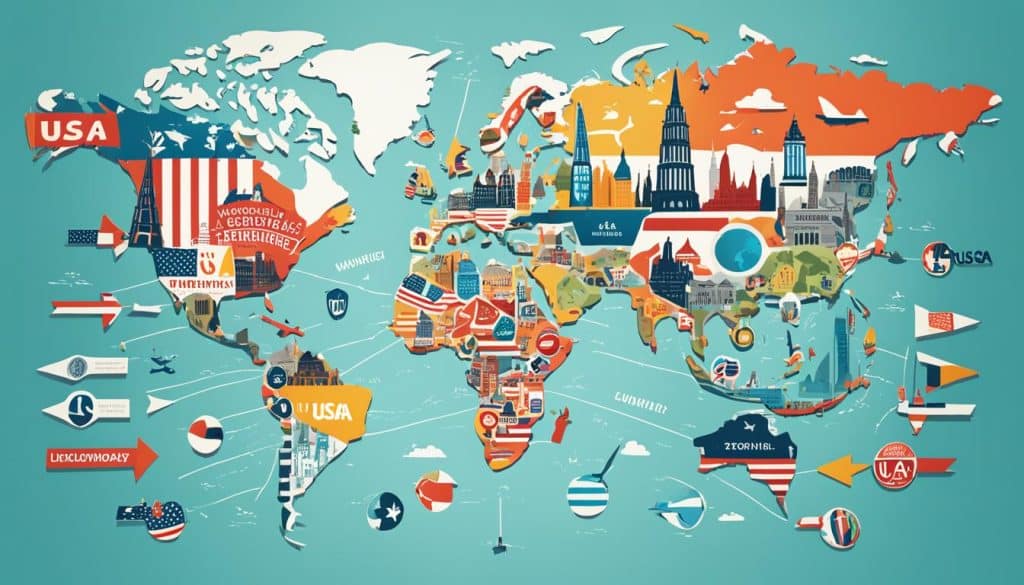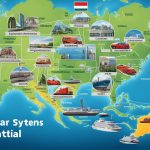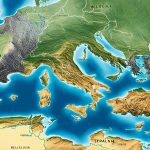When we look at business on both sides of the Atlantic, stark differences pop up. This is not just about where they are. It’s about how they deal with global market challenges under different rules and cultures. For businesses wanting to grow internationally, knowing these differences is key to success.
What makes doing business in cities like New York or San Francisco different from London or Berlin? It’s more than just the distance between them. Local culture and government rules play a big part in how companies work. Let’s explore these unique strategies in the business world across the Atlantic.
Introduction to Transatlantic Business Comparisons
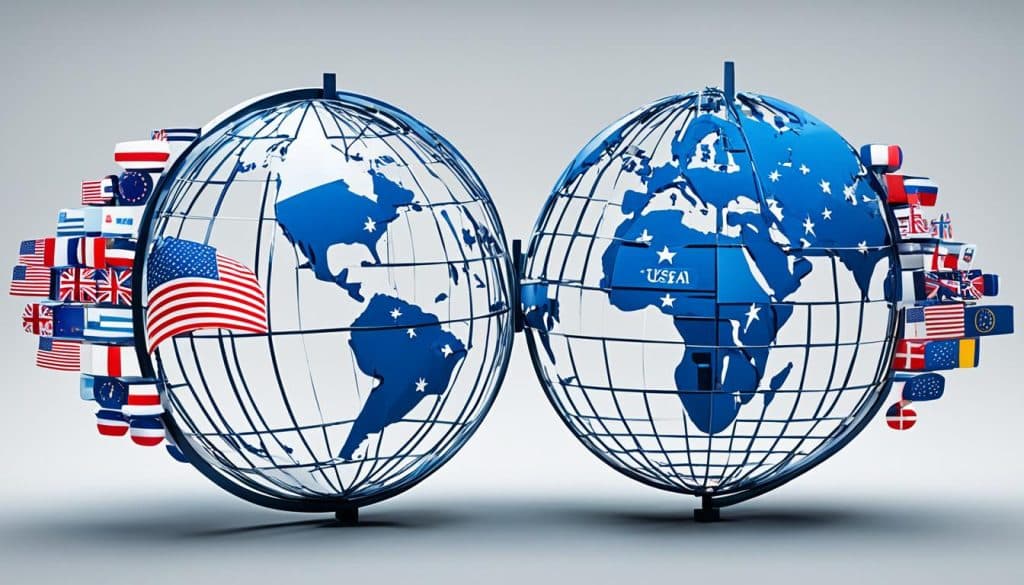
The link between the US and Europe has always been key to world trade. The way businesses interact across the Atlantic is both interesting and diverse. For companies aiming to thrive in global trade, understanding these markets is key.
Globalisation has tightly woven the US and Europe’s business futures together. It’s vital to look at how they operate for anyone entering this field. We’ll explore the main parts of this business landscape and how US and Europe trade merges:
- Historical Legacy: The past shapes today’s business methods and guides future US-Europe partnerships. It shows how business thoughts have evolved.
- Trade Agreements: Rules that help or hinder trade, like tariffs and agreements, impact business operations. They can help companies grow or limit their market reach.
- Cultural Nuances: Understanding the cultural differences in business across the US and Europe is crucial. It can often lead to successful deals and partnerships.
The US-Europe business relationship is a mix of cooperation and competition. By closely looking at the markets, both sides can use their strengths. This way, they can open new markets and build stronger economic bonds.
This opens our journey into transatlantic business comparisons. We aim to uncover the key economic links that connect two major world economies.
Key Industries Driving the Economy in the USA and Europe
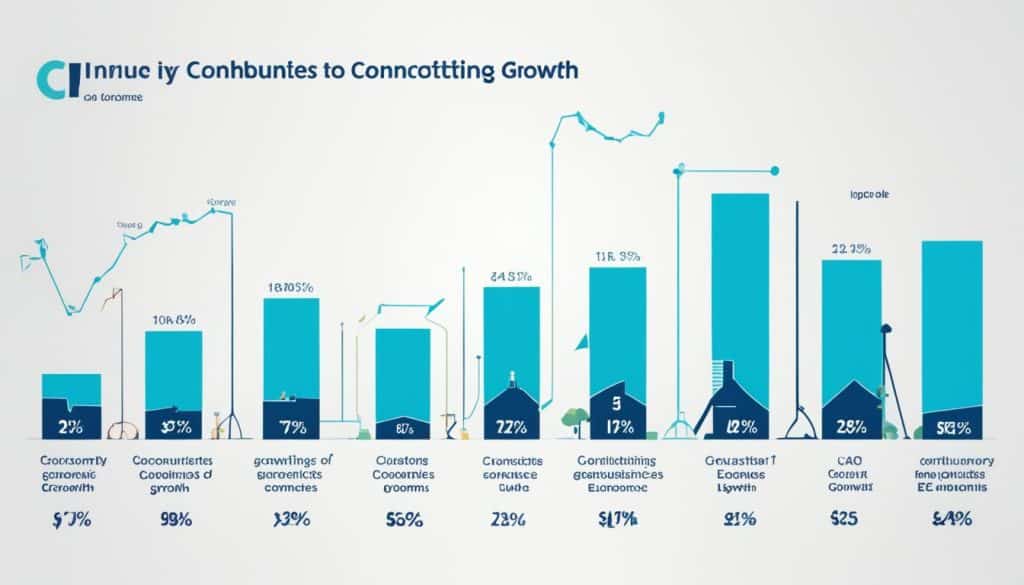
The importance of the leading industries in the USA and Europe is huge. These areas lead in fields like technology, cars, and finance. They are always changing fast. We explore how these sectors change the West’s economy. We look at tech developments in Silicon Valley and Europe, car industry competition, and changes in finance. This shows how industries grow and compete.
Technology Sector Trends
The technology sector is where new ideas are born. It’s a field where Silicon Valley and European tech areas try to outdo each other. They develop in AI, cloud services, and cybersecurity. The USA and Europe are trying hard to lead in tech. This competition helps their economies grow a lot.
Automotive Industry Developments
The car industry is also a place of big competition. Makers in the USA and Europe are fast changing how we think about cars. They are moving towards electric cars. This change is tough but also opens new chances. Car companies are transforming to fit a greener future.
Financial Services Innovations
The change in financial services completes the picture. It’s about the battle between old banks and new FinTech companies. This change touches both the USA and Europe. FinTech is making everything new again. And it’s keeping the financial market safe and growing. This shows how the finance sector is always updating.
Start-Up Ecosystem: Silicon Valley vs European Tech Hubs
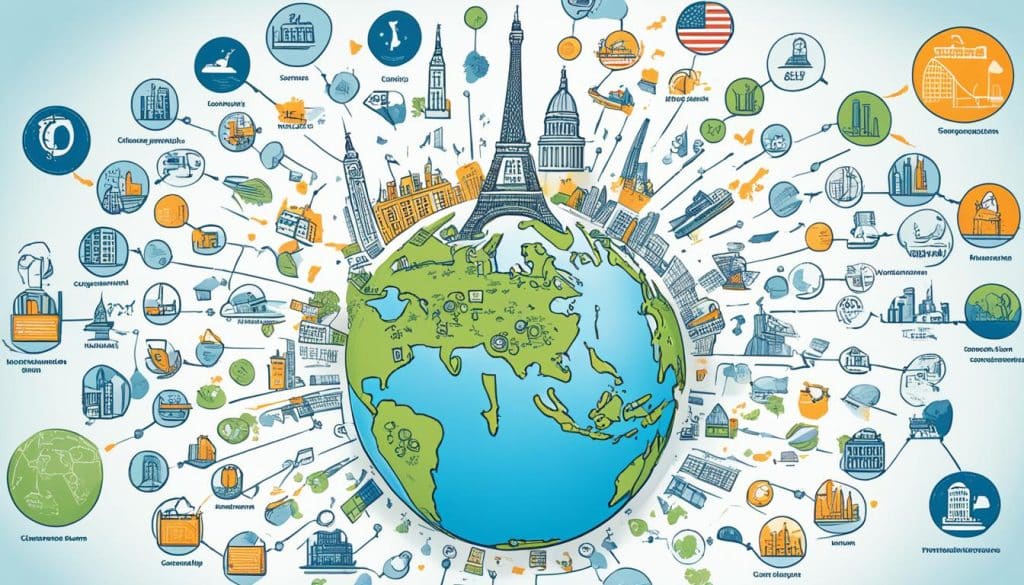
The vibrancy and resilience of a start-up ecosystem significantly affect its global influence and sustainability. Silicon Valley sets the standard for start-up cultures, offering key insights into venture capital and strategies for innovative global growth. Yet, Europe’s emerging tech hubs in cities like London, Berlin, and Stockholm are quickly advancing. They benefit from distinct start-up regulations. Let’s explore how the start-up scenes differ across the Atlantic.
Comparison of Venture Capital Availability
Venture capital is crucial for start-up growth. In Silicon Valley, investors are known for their bold funding tactics. They often provide significant capital to tech start-ups. On the contrary, European venture capitalists are more cautious, performing thorough due diligence. This difference in risk-taking affects the availability of venture capital in these areas.
Success Rates and Scaling Internationally
Understanding a start-up’s ability to scale up internationally is key to assessing its success rate. Silicon Valley start-ups typically aim for quick global expansion. European start-ups, however, usually prefer to conquer local markets first before going global. This careful approach may slow down their global scaling strategies. Yet, it might lead to more sustainable growth over time.
Regulatory Environment for Start-Ups
The regulations for start-ups differ greatly between the US and Europe. In Silicon Valley, the regulatory framework supports fast-paced innovation and quick market entry. Meanwhile, Europe’s regulations, though stricter, strive for a balance between innovation, social responsibility, data protection, and consumer rights. These differences in regulations fundamentally influence how start-ups develop and function in their specific regions.
Market Accessibility and Consumer Behaviour

Understanding how to access different consumer markets is key for companies wanting to grow overseas. They must consider how US and European consumer trends differ and plan accordingly. This section looks at what companies need to think about to appeal to consumers across these two regions.
-
Shopping habits vary between the US and Europe. Americans often like large stores where they can buy everything in one go. Europeans, however, prefer smaller shops that specialise in certain products and value brand loyalty highly.
-
Both Western Europe and the US have strong economies, requiring careful market entry plans. Eastern Europe offers chances for quick growth, with its own unique needs and challenges.
-
What shoppers expect can differ greatly. In Europe, there’s a strong focus on eco-friendly products. In the US, buyers look for convenience and excellent customer service. Companies must meet these expectations to succeed.
Companies looking to expand into these areas must customize their strategies. They cannot use the same approach everywhere. By understanding and adapting to US and European consumer trends, businesses can succeed in these diverse markets.
Retail Giants: Walmart vs Carrefour
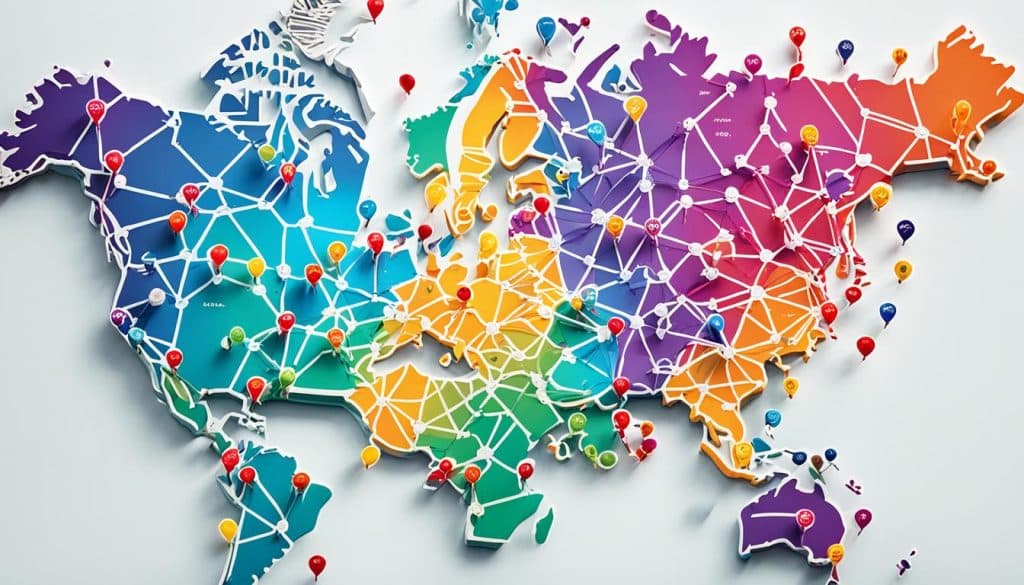
Walmart and Carrefour are giants in retail, and they both use smart strategies to stay on top. They have embraced changes in how we shop both in-store and online. Their efforts in expanding globally and improving how we shop show their commitment to serving diverse buyers.
Strategies in Brick-and-Mortar Retail
Walmart and Carrefour use different tactics to make shopping better for everyone. Walmart offers a broad selection of goods at low prices across its US stores. Carrefour focuses on matching its products and stores to what local people like in Europe.
E-commerce Platforms and Adaptation
The move to online shopping is key, and both retailers are investing in it. Walmart is improving its digital and physical shopping blend by buying online businesses and bolstering Walmart.com. Carrefour is also making strides with digital efforts to make shopping seamless, whether online or in-store.
Global Expansion and Localisation Efforts
Both companies use smart local tactics as they grow worldwide. Walmart adjusts its offerings and marketing to match local tastes. Carrefour uses flexible supply chains and works with local suppliers to cater to every market’s needs.
Healthcare Systems: Private vs Public Models

When we look into healthcare in the United States versus Europe, we see US private healthcare is different from European public health services. These differences affect how businesses run, their efficiency, and the patient experience.
In the US, healthcare mainly comes from private companies. People often use insurance to pay for their health services. This creates a battle among insurance companies to win customers. They focus a lot on marketing and making their services stand out.
To be successful, these companies need to invest in technology and customer support. This way, they can provide quick and satisfying healthcare to their customers who pay.
US private healthcare leads to new medical breakthroughs. This happens because companies want to fulfill the demands of their customers.
In Europe, the story is different. They usually have public health services paid for by taxes. The goal is to give everyone access to healthcare, no matter how much money they have.
Having healthcare as a right means these countries work to make sure everyone can get the services they need without spending too much money.
In Europe, the challenge is to keep costs down while still offering quality healthcare.
The US system offers many choices and high-quality care for those who can afford it. On the other hand, Europe tries to ensure basic healthcare for everyone. Both face challenges. The US has to deal with people without insurance. Europe struggles with waiting times and limiting services.
People often debate which healthcare system is better. To really judge, we must consider the quality of care right away and in the long term. Also, how happy people are with these systems matters a lot.
Businesses in USA and Europe
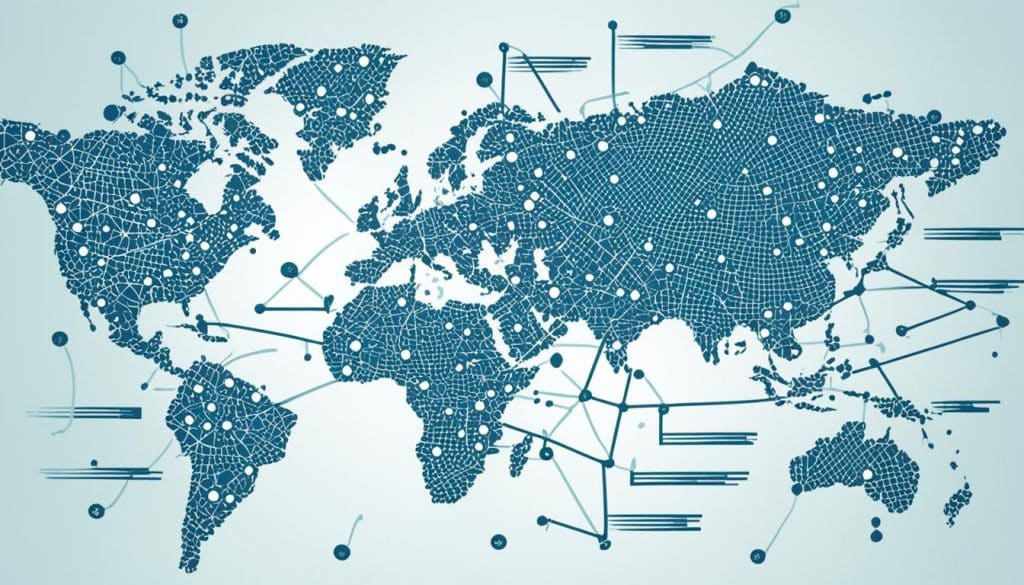
When businesses expand overseas, they face new challenges. They must understand and adjust to local quirks. This includes dealing with differences in management culture, labor laws, and environmental policies. These factors can change how companies work when they move between continents.
Cross-Cultural Management Practices
Different cultures manage businesses in various ways. Learning to work with these differences is crucial. It’s not just about new languages or customs. It’s about valuing diverse thinking and problem-solving. Leaders who see cultural diversity as a benefit, not a problem, tend to succeed.
Labour Laws and Workers’ Rights
The USA and Europe have different approaches to labour laws. The USA has a flexible job market. But European laws offer more protection to workers. This makes running a business more complex in Europe due to these rules.
Environmental Regulations Affecting Business Operations
Environmental policies are key for companies working in different countries. The USA and Europe have different rules about the environment. Europe often leads in sustainability. Companies have to find ways to follow these rules without losing money. This shows how resilient a company can be in the future.
Manufacturing Powerhouses: Automation and Efficiency
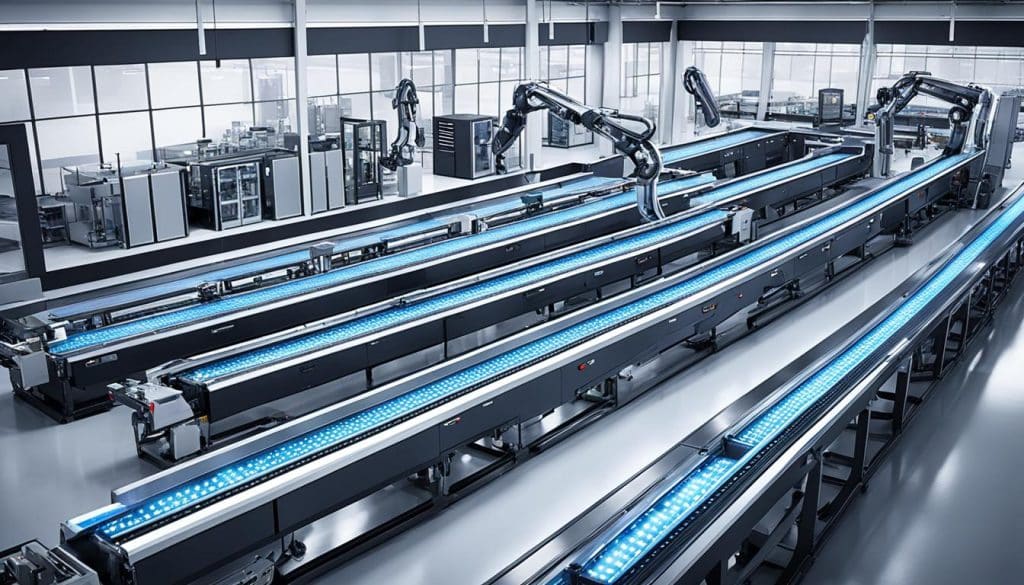
The use of manufacturing industry automation has hugely improved operational efficiency in manufacturing worldwide. This key development varies between the United States and Europe, with each adopting unique production strategies. Looking into these methods highlights their effort to stay competitive and update their industrial scenes.
In the United States, automation in the manufacturing domain aims to outpace global markets. Key focuses include customization and adaptability. Meanwhile, European manufacturing places a high value on automation too. It greatly enhances accuracy and lowers waste, fitting well with aims for environmental care. Both areas are constantly upgrading, showing their commitment to making their industries future-ready. They use new technology and the idea of smart factories.
- Adoption of Robotic Process Automation (RPA) to streamline production lines
- Implementation of Internet of Things (IoT) devices for real-time data analysis and predictive maintenance
- Integration of Artificial Intelligence (AI) to optimise supply chain management and resource allocation
When comparing US vs Europe production strategies, clear differences show. The US is quick to take on new technologies, with significant investments pushing for innovation. On the other hand, Europe moves more carefully. It puts a stronger emphasis on the rights of workers and the broader social effects of automation. This affects how fast and widely automation is embraced.
Finding the right mix between using manufacturing industry automation for a competitive edge and caring for the workforce is a shared goal. Both the US and Europe face this challenge. As they do, they are setting examples for operational efficiency in manufacturing. These examples could reshape the future of how industries work.
Energy Sector: USA’s Oil vs Europe’s Renewables
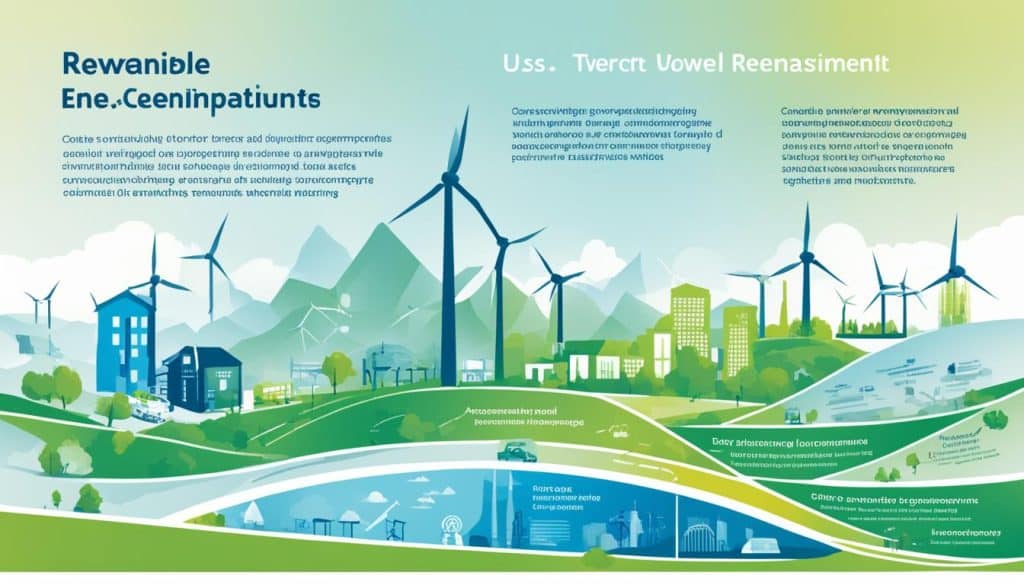
The energy sector is experiencing a major change. Comparing the energy industry in different regions highlights big differences. In the USA, the focus is on oil, especially through fracking. Europe, however, is investing in renewable energy like wind and solar power. This situation shows a battle between old and new energy sources. It highlights the need to study the fracking industry and recognise the progress in renewables.
The Fracking Boom and Its Global Impact
Fracking in America has grown quickly. This method gets oil and gas from rock. It has made the USA a top energy producer. This growth has changed energy policies in the USA and affected energy prices and politics worldwide.
Europe’s Pioneering in Wind and Solar Energy Technologies
Europe is moving forward with renewable energy. It is leading in wind and solar power technology. European countries are increasing these technologies’ power and efficiency. They aim to lead the world in using more green energy.
Policy and Investment in Energy Infrastructure
A comparison between the USA and Europe shows they have different energy strategies. The USA supports fracking, which has brought economic benefits and power. Europe prefers to support renewable energy through laws. These decisions have big impacts on the energy world and future innovations.
- Assessment of fracking’s role in economic prosperity versus environmental concerns
- Progressive European policies fostering growth in renewable sectors
- Strategic investments impacting long-term energy sustainability
The difference between using old and new energy sources is clear. Both policy decisions and new technologies show we are at a turning point. The energy industry, and the world, are facing a big change in how we use energy.
Banking Industry: Wall Street and European Banks

The financial world constantly changes due to new rules, global events, and tech upgrades. An analysis shows America and Europe’s economies depend on their banking sectors’ strength and creativity. We will look into how rules, Brexit, and FinTech shape finances on both sides of the Atlantic.
Financial Regulation and Consumer Protection
Comparing U.S. and European financial laws is complex but vital. Europe strives for a united, strict rulebook to protect consumers and lower risks. The U.S. sees state and federal levels each provide different protection levels.
Impact of Brexit on Financial Services
Brexit’s effect on banks is both interesting and worrying. With the UK leaving the EU, the way financial services move across borders has changed. Banks need to adapt to new market rules and regulations. The full effect of this change is still unfolding.
Innovation in Banking: FinTech’s Role in Shaping the Future
FinTech is drastically changing banking worldwide. It focuses on customer satisfaction and uses the latest technology. Examples include blockchain, artificial intelligence, and mobile banking. This pushes both old and new banks towards being more flexible and customer-friendly.
Agricultural Practices: Organic Trends and GMO Policies

When we look at farming in the US and Europe, we see different trends. Organic farming is becoming more popular because people want products that are good for the planet. This is happening in both places, but the way they do it can be different.
Comparing trends, we find that views on GMOs (genetically modified organisms) are a big conversation starter. The US is ok with using GMOs because they can help with feeding more people and making farming better. Europe, however, is very careful with GMOs. They worry about the environment and what people think.
These approaches are shaping farming in big ways:
- The organic farming growth trend shows that people everywhere are choosing healthier food and natural ingredients.
- In Europe, organic farming gets a lot of support from a policy called the Common Agricultural Policy (CAP). It offers benefits for farming in ways that are good for our planet.
- The GMO regulations impact is really felt in Europe. Because of strict rules, how GMO products are brought in, grown, and labelled really changes how they do business with places that are ok with GMOs.
- Comparing trends between the US and Europe shows they are going in different directions. The US is all about using science to make farming better. Europe prefers to stick with organic and traditional ways.
What this means is that farming businesses need to be able to change and adapt. They must keep up with what people want and how rules might be changing where they work.
The Impact of Trade Agreements on Businesses
International trade agreements shape how businesses work around the world. They guide the flow of goods and influence key business decisions. These agreements, like USMCA and the European Union Single Market, have different rules for access and tariffs. Businesses must understand and navigate these differences carefully.
NAFTA vs EU Single Market: Access and Tariffs
The shift from NAFTA to USMCA has brought changes affecting many industries. It has altered how market access and tariffs are viewed in North America, introducing new rules for digital trade and intellectual property rights. On the other hand, the EU Single Market continues to support trade in Europe. It promotes free movement of goods, money, services, and labour, aiding in easier market access.
International Trade Wars: Effects on SMEs
Trade wars are changing the way international business is done. They especially challenge small and medium-sized businesses. For instance, the tension between the USA and China disrupts supply chains. It creates uncertainty, forcing businesses to adapt quickly to survive in this uncertain environment.
Future Trade Prospects Post-Brexit
Britain’s exit from the EU changes the game for international trade. This transition opens up new opportunities and challenges for businesses in the USA and Europe. Companies must adjust their game plans to navigate the new trade rules and regulations. The UK is looking to forge new trade deals that will shape its future in international trade.

